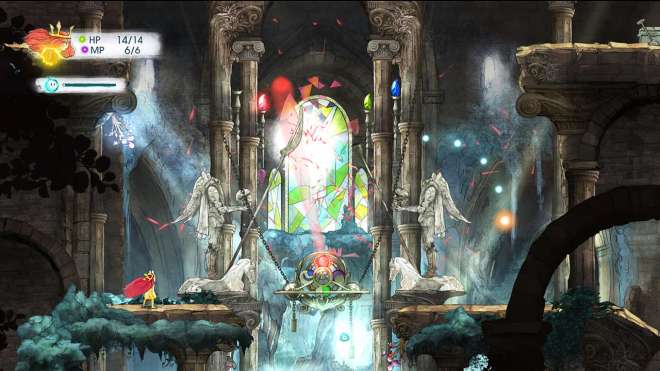Child of Light is chasing an aesthetic. A cauldron of beautiful art, tranquil music, and a fairy tale story influenced by Disney and Studio Ghibli classics.
The art is indeed gorgeous and mixed with the subdued orchestral tinkling, the atmosphere of the game emerges with an austere beauty. It is the whimsy that is lacking; the dialogue is all text (no speech), and generally rhymes. There’s sad clowns, mercantile mice, 13 year olds with beards. A city where all inhabitants were turned to crows, a city built upon a giant’s scalp. The stuff of Roald Dahl and Norton Juster, but Phantom Tollbooth this is not. It’s hard to make such wonder so bland, especially when backed by such pretty artwork, but the sad truth is that the writing is just not that good. For a tale relying so heavily on rhyme, the couplets do not flow well at all and require some mental word twisting to work out the rhyme. The characters aren’t particularly charming or worthy of emotional investment.
The game starts poorly. You control a single character, walking around a 2d world that does seem particularly friendly to walking. I almost put the game down. But 30-45 minutes in, the little-girl protagonist, Aurora, gains the ability to fly and the gameplay vastly improves. You increase the size of your party and the enemies increase the size of theirs and it starts to feel like a real game.
The combat in Child of Light is reminiscent of the old Super Nintendo Final Fantasy games. Touching an enemy out in the world swaps to a separate screen where your party engages the enemy in turn-based combat. All characters, friend and foe, show up on a bar called the timeline and their portraits move from left to right, and when they reach 80% of the way to the far right, the player can choose an attack. If the character is attacked in the remaining 20%, they lose their move and are shunted backwards down the timeline. The player can only control 2 characters at a time but can seamlessly swap in dormant party members mid-combat.
It’s pretty fun. On the harder of the two difficulties, fights generally require a strategic approach. The game eventually starts to suffer from repetition as every boss fight is a main beastie with two henchmen and the strategy of carefully killing one, then two, and stabilizing to take down the major enemy works literally every time. The game is short so the repetition does not get too tiresome, but I can’t shake the feeling that a more creative approach could have led to far more varied battles.
All said, the game was pretty if a bit sterile. I miss turn based RPGs, so even if it was far from perfect, I’m thankful this game exists and I stuck it out beyond the flightless first act. And it really was very pretty.
